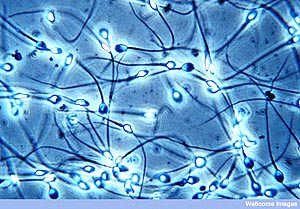Mutant sperm guide clinicians to new diseases

The scientists from the Wellcome Trust Sanger Institute looked at four unstable regions in the genome where rearrangements cause genetic diseases, so-called ‘genomic disorders’, and found that some of these rearrangements were found in sperm much more frequently than expected.
In work published in November 2006, the team, led by Dr Matt Hurles, showed that losses or duplication of ‘chunks’ of the human genome occurred frequently in apparently healthy people. These losses or gains of DNA regions are called Copy Number Variants (CNVs), and can be found all over the genome in every individual.
Some of the mechanisms thought to produce CNVs would be expected to produce about one duplication for every deletion: however, clinical records for genomic disorders show only a few duplications, compared with hundreds of deletions.
“There was no direct, global measure of the relative rate at which human DNA is gained or lost, a study that requires many thousands of human genomes, so we carried out a study on four clinically important regions using human sperm cells as our population of genomes.
“Sperm cells give us an unbiased snapshot of CNVs: using our new highly-sensitive assays we can detect one rearrangement in a million cells.”
Dr Matt Hurles Investigator at the Wellcome Trust Sanger Institute
The team looked at regions known to be affected by rearrangement in Williams-Beuren Syndrome, Charcot-Marie-Tooth disease Type 1A, Smith-Magenis Syndrome, and a deletion (AZFa) that causes male infertility. Their study showed that duplications are about half as frequent as deletions. By contrast, the two types of CNV are similarly common in healthy adults, suggesting that some deletions are too detrimental for the genome to tolerate.
“It is likely that deletions are more harmful than duplications, perhaps because a vital gene is removed, and so less likely to survive. However, for some of the genomic regions we looked at, duplications can cause milder symptoms. Perhaps we can improve diagnosis with improved understanding of the possible consequences of duplications.”
Dr Matt Hurles Sanger Institute
In Williams-Beuren Syndrome, loss of a genomic region (which can vary in size) can have very severe effects, including narrowing of arteries, facial and other skeletal deficiencies and impaired mental development. By contrast, duplications of the same regions have a milder effect, resulting most commonly in delay of speech development. With the results of this study, the team suggest that improved diagnosis might result from examining speech-delay for CNVs in this region.
“Although some of these CNVs arise much more frequently than anyone thought, they are still comfortingly rare: we see them in about 1 in 50,000 sperm cells. These are unfortunate accidents of the essential shuffling of our genetic deck of cards, a process essential to human life. We need a new deal for each new person.”
Dr Matt Hurles Sanger Institute
The method should also be able to detect rearrangements where none was suspected and to predict new disease-causing variants. Indeed one of the duplications that was detected in sperm has not yet been observed in the clinic, and yet it can be expected to cause disease, because smaller duplications of the same region cause Potocki-Lupski syndrome. Clinical genetics usually proceeds from observations in a patient down a long road to identify the gene involved. The new CNV work opens a new and possibly quicker, route of using new mutations found in sperm to lead to disease-causing mutations in patients.
In their work in 2006, the team has developed the CNV map for apparently healthy people: many of these are unlikely to cause disease. By looking across the entire genome for novel CNVs in human sperm, they will be able to predict where CNVs are likely to play a possible undiscovered role. In this ‘reverse genetics’, the new methods move from genome to prediction of consequences for patients.
This work complements the systematic cataloguing of CNVs that do cause disease by the Institute’s DECIPHER consortium.
More information
Disorders in OMIM
Publications:
Selected websites
The Wellcome Trust Sanger Institute
The Wellcome Trust Sanger Institute, which receives the majority of its funding from the Wellcome Trust, was founded in 1992. The Institute is responsible for the completion of the sequence of approximately one-third of the human genome as well as genomes of model organisms and more than 90 pathogen genomes. In October 2006, new funding was awarded by the Wellcome Trust to exploit the wealth of genome data now available to answer important questions about health and disease.
The Wellcome Trust
The Wellcome Trust is the largest charity in the UK. It funds innovative biomedical research, in the UK and internationally, spending around £500 million each year to support the brightest scientists with the best ideas. The Wellcome Trust supports public debate about biomedical research and its impact on health and wellbeing.


